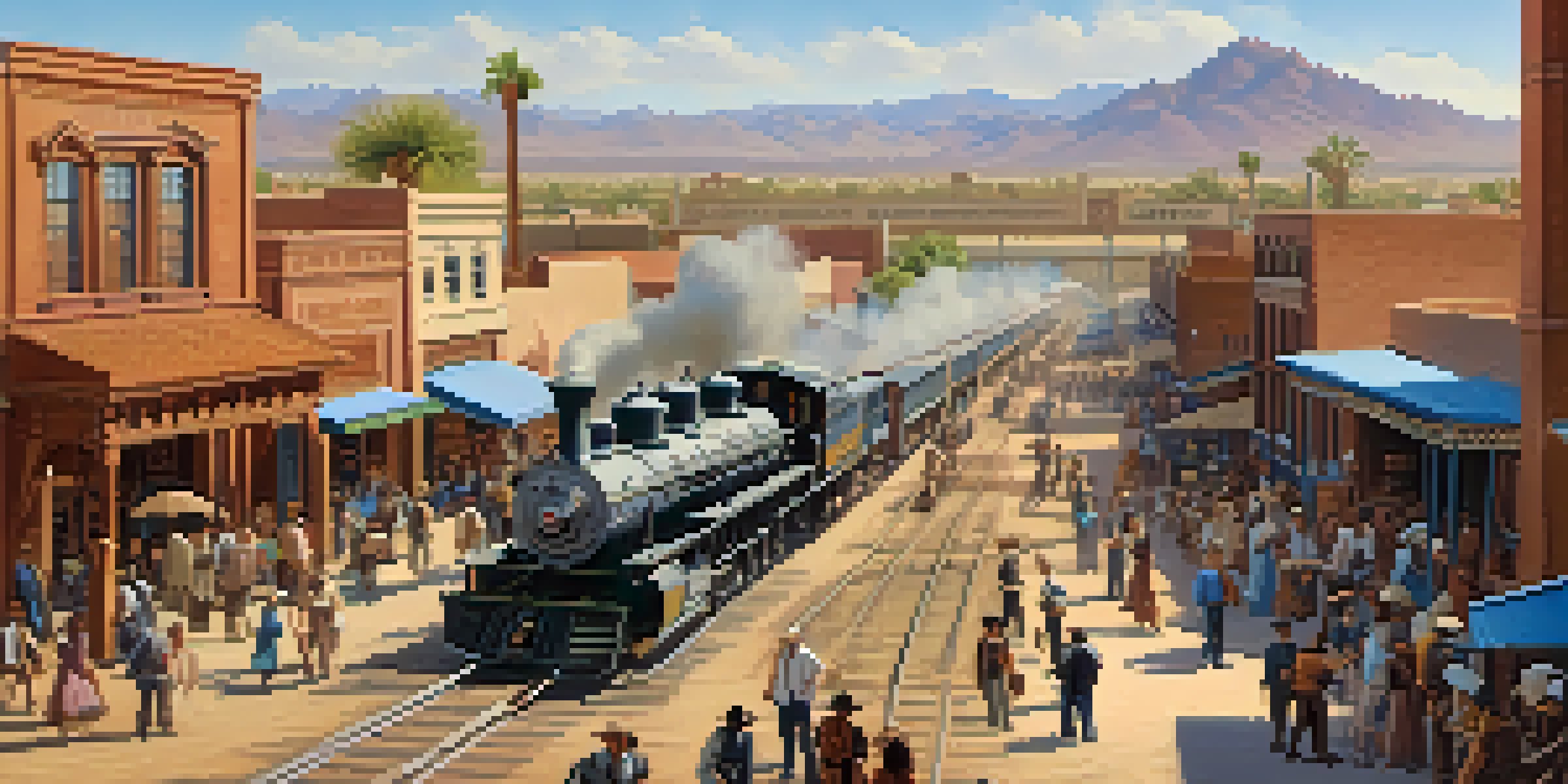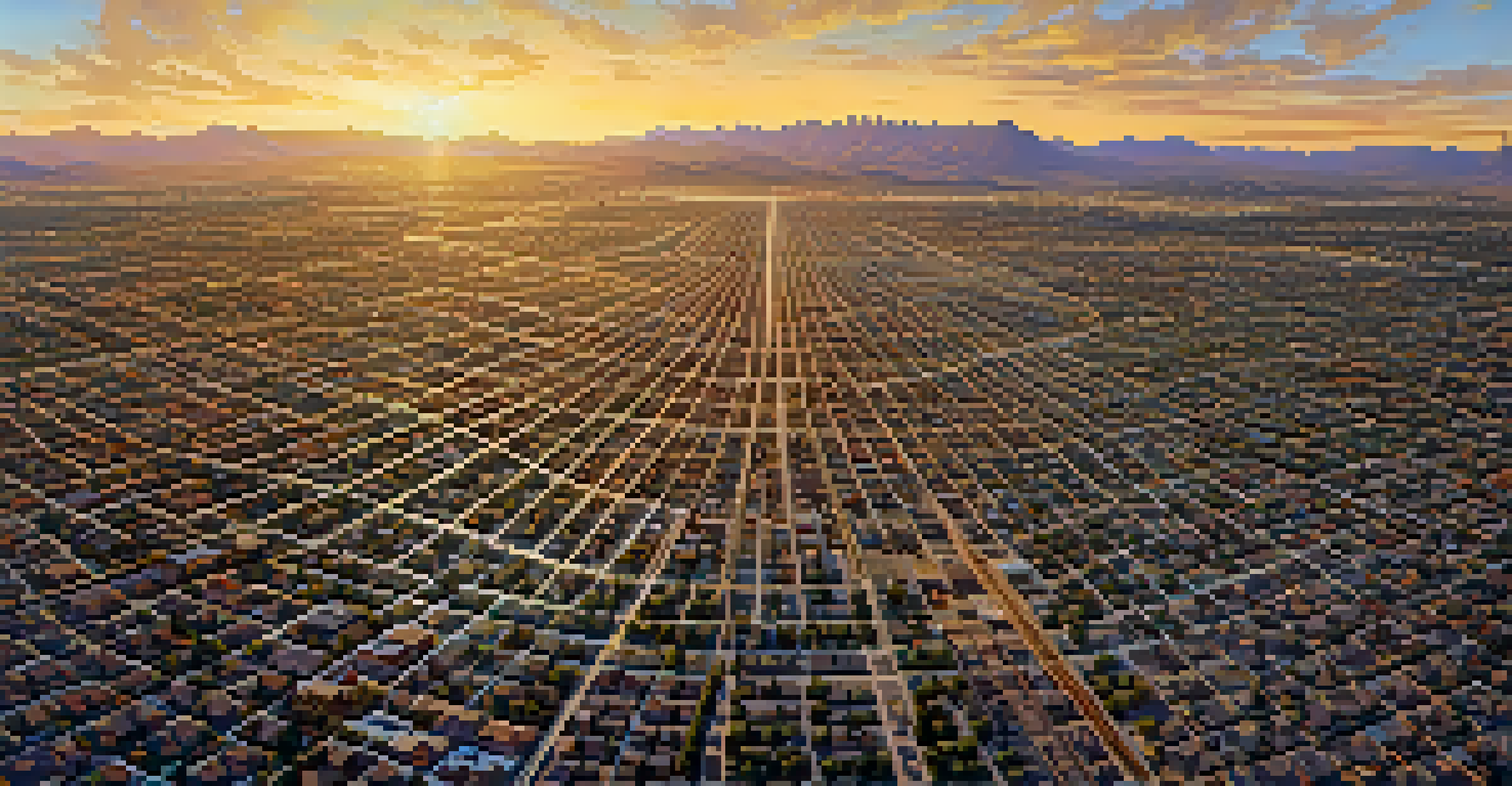Phoenix's Railroads: Key Events that Shaped the City’s Landscape

The Birth of Railroads in Phoenix: A New Era Begins
The arrival of railroads in the late 19th century marked a turning point for Phoenix. In 1887, the Southern Pacific Railroad laid tracks through the city, connecting it to major markets and resources. This newfound accessibility attracted settlers and entrepreneurs, eager to capitalize on the booming economy.
The railroads are a vital part of America's economic infrastructure, connecting communities and fostering growth.
As the railroads expanded, they transformed Phoenix from a small agricultural hub into a bustling city. The ability to transport goods efficiently helped local farmers thrive while also supporting a growing population. This influx of people and commerce set the stage for urban development that would shape Phoenix's identity.
Railroads not only brought economic opportunities but also fostered cultural exchanges. As diverse groups settled in Phoenix, they contributed to a vibrant community, enriching the city’s cultural tapestry. The early days of railroads laid the foundation for the modern metropolis we see today.
Key Railroads and Their Impact on Phoenix's Growth
Several railroads played pivotal roles in shaping Phoenix's landscape. The Southern Pacific Railroad was the first, but the Atchison, Topeka and Santa Fe Railway also significantly impacted the region. These railroads facilitated the transport of agricultural products, minerals, and manufactured goods, boosting the local economy.

The competition between railroads encouraged innovation, leading to better services and infrastructure. As the rail network expanded, it connected Phoenix to national markets, enabling businesses to thrive. This competition also led to the development of new neighborhoods along the rail corridors, further spreading the population.
Railroads Fueled Phoenix's Growth
The arrival of railroads transformed Phoenix from a small agricultural hub into a thriving city by connecting it to major markets.
Moreover, the railroads influenced the city’s spatial organization, creating hubs around stations that evolved into important commercial areas. This spatial planning laid the groundwork for Phoenix's urban layout and contributed to its growth as a regional powerhouse.
The Role of Railroads in Phoenix’s Economic Development
Railroads were instrumental in driving Phoenix's economic development. By facilitating the movement of goods, they enabled local industries to flourish, including agriculture and mining. This connection to larger markets allowed Phoenix to become a key player in regional trade.
Transportation is the backbone of our economy, and railroads play a crucial role in the movement of goods and people.
As businesses grew, they attracted more workers, leading to population increases. The railroads not only brought in labor but also improved living standards by providing access to essential goods and services. This economic boom contributed to the rise of a middle class in the city.
Furthermore, the railroads created jobs directly related to transportation and logistics, adding to the city's economic diversity. This laid a strong foundation for future industries and innovation, solidifying Phoenix's role as a hub of commerce.
Urban Development: How Railroads Shaped City Layout
The layout of Phoenix was profoundly influenced by the location of railroads. Early settlements often sprouted around railroad stations, which became focal points for businesses and residential areas. This pattern established a grid-like structure that characterized the city’s development.
As railroads expanded, they not only shaped the geography but also dictated the flow of commerce. Major thoroughfares emerged around these rail lines, facilitating transportation for both residents and goods. This infrastructure became crucial for the city’s growth and planning.
Cultural Exchange Through Railroads
Railroads facilitated the arrival of diverse populations, enriching Phoenix's cultural landscape and fostering community growth.
Additionally, the presence of railroads spurred the development of public transportation options, further connecting neighborhoods and enhancing mobility. This accessibility helped create a sense of community and supported the city’s rapid expansion.
Cultural Exchange and Community Growth Through Railroads
Railroads were more than just transport systems; they were conduits for cultural exchange. As diverse populations arrived in Phoenix, they brought unique traditions, cuisines, and perspectives that enriched the local culture. This blending of cultures created a vibrant and dynamic community.
Cultural events and festivals began to flourish, reflecting the diversity of the city's inhabitants. Railroads facilitated travel to and from these events, allowing for greater participation and celebration of cultural heritage. This cultural tapestry became a cornerstone of Phoenix's identity.
Moreover, the railroads contributed to social integration by connecting different neighborhoods. As people from various backgrounds interacted, they fostered a sense of unity and belonging within the city. This cultural synergy has continued to shape Phoenix into a welcoming and inclusive place.
Challenges Faced by Railroads in Phoenix's History
Despite their significant contributions, railroads in Phoenix faced numerous challenges. The Great Depression in the 1930s severely impacted the economy, which in turn affected rail traffic and operations. Many rail companies struggled to stay afloat, leading to service reductions and layoffs.
Additionally, the rise of automobiles changed the landscape of transportation. As more people opted for personal vehicles, railroads saw a decline in passenger numbers. This shift forced rail companies to adapt, often leading to reduced services and a focus on freight transport instead.
Future Innovations in Rail Transport
Investments and technological advancements are set to revitalize Phoenix's rail systems, promoting sustainable urban development.
Environmental concerns also emerged, with communities advocating for cleaner transportation alternatives. These challenges prompted discussions about the future of railroads in Phoenix, leading to innovative solutions and adaptations in the face of changing times.
The Future of Railroads in Phoenix: Trends and Innovations
Looking ahead, railroads in Phoenix are poised for a renaissance. Recent investments in public transportation, including light rail systems, indicate a renewed commitment to rail transit. These developments aim to alleviate traffic congestion and promote sustainable urban growth.
Innovations in technology also play a role in shaping the future of railroads. From improved safety measures to more efficient freight systems, advancements are helping railroads adapt to modern demands. This focus on innovation is crucial for maintaining the relevance of rail transport.

Moreover, as cities increasingly prioritize sustainability, railroads offer an eco-friendly alternative to road transport. The potential for expanding rail networks in Phoenix presents opportunities for economic growth while addressing environmental concerns, ensuring that railroads remain integral to the city’s future.